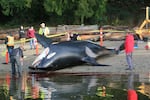
The 18-year-old male southern resident killer whale J34, stranded near Sechelt, British Columbia on December 21, 2016. Postmortem examination suggested he died from trauma consistent with vessel strike.
Paul Cottrell / Fisheries and Oceans Canada
Researchers have long known that dwindling salmon runs, water pollution and loud underwater boat noise are major contributors to the reduced number of orcas along the West Coast.
Now, a ten-year study of killer whale carcasses found washed up on beaches in the eastern Pacific Ocean has found a significant number who died from more direct human causes.
“This study was really a decade-long look at what do killer whales die from, from California to Alaska all the way out to Hawaii,” said Joe Gaydos, a wildlife veterinarian with UC Davis who participated in the study. “The idea is that, if we can figure that out, we might be able to find some ways that we can further help recover the endangered population, like Southern residents.”
The so-called southern resident orcas make their home in the inland waters of Puget Sound and southern British Columbia. They’ve been listed as endangered because their numbers have plummeted in recent years. A similar but larger population of orcas that inhabits the waters of northern B.C., known as the northern residents, is listed as threatened under Canada’s Species At Risk Act.
Gaydos said one of the most striking findings of the study is how broad the human harm was across the orca population.
“In every single age class – calves, sub-adults, adults – we saw human-caused reasons to them to die,” he said. “So maybe being hit by a boat or having an infection from a fishing hook that was found in their stomach.”
Gaydos acknowledged the study is an incomplete picture of how so-called “killer whales” die. Only a small portion of carcasses washed up where researchers could find them and the cause of death could be determined in fewer than half.
Still, he said, the evidence of direct injury to orcas from human activities points to the need for greater awareness of the ways the animals can be harmed and for humans to do more to protect them.
The study was led by the Ministry of Agriculture in British Columbia and coordinated through the SeaDoc Society, a program of the UC Davis School of Veterinary Medicine, with help from NOAA Fisheries and Canada;s Department of Fisheries and Oceans.
The study was published in the journal Plos One.